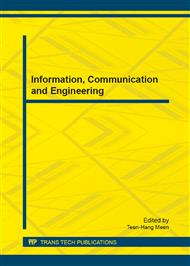p.485
p.491
p.497
p.502
p.507
p.512
p.518
p.527
p.533
A Study on the Sleep Forehead EEG
Abstract:
The purpose of this study was to utilize prefrontal EEG to discuss the theta EEG on the sleep quality of good and poor sleepers. Prefrontal EEG was chosen as it was positively correlated with reduced performance on neuropsychological tasks during total sleep deprivation. Hence, two test groups of ten volunteers were taken as test groups of good and poor sleepers. In addition, six tasks were performed using single channel forehead EEG. Results showed that audio stimulation provided the largest difference in theta amplitude between good and poor sleepers. Second, a large difference in the theta amplitude could be observed before and after the audio stimulation for poor sleepers. Third, it was also proven that prefrontal EEG could be conveniently applied for studying poor sleep qualities as it exhibited significant changes in the subject’s prefrontal EEG after biofeedback stimulation. In conclusion, the current research was able to provide significant differences between good and poor sleepers using prefrontal EEG through measuring and analyzing EEG theta wave.
Info:
Periodical:
Pages:
507-511
Citation:
Online since:
February 2013
Authors:
Keywords:
Price:
Сopyright:
© 2013 Trans Tech Publications Ltd. All Rights Reserved
Share:
Citation:


